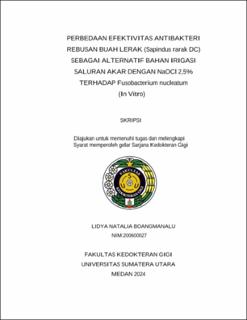Perbedaan Efektivitas Antibakteri Rebusan Buah Lerak (Sapindus Rarak Dc) Sebagai Alternatif Bahan Irigasi Saluran Akar dengan Naocl 2,5% Terhadap Fusobacterium Nucleatum (In Vitro)
The differences in Efectiveness of Lerak Fruit Decoction (Sapindus rarak DC) as an Alternative Root Canal Irrigation with Sodium Hypochlorite 2,5% Against Fusobacterium nucleatum (In Vitro)
Abstract
Irrigation plays an important role in root canal treatment. There is no irrigation material that meets the ideal requirements for irrigation materials. Lerak fruit contains active compounds that are antibacterial so that it can be used as an alternative root canal irrigation material. The purpose of this study was to determine the antibacterial effect of lerak fruit (Sapindus rarak DC) decoction as an alternative root canal irrigation material against the growth of Fusobacterium nucleatum bacteria by finding the minimum inhibitory concentration and minimum bactericidall concentration values. This type of research is laboratory experimental research with post test only control group design using Fusobacterium nucleatum ATCC 25586 samples. MIC and MBC values were determined by Miles Misra's Drop Plates method. Lerak fruit decoction was diluted with BHIB through the dilution method, so as to obtain 100%, 50%, 25%, 12.5%, 6.25%, and 3.125% with 4 replications in each treatment group including 2.5% NaOCl, filled with 0.1 ml bacteria, then homogenized and incubated for 48 hours at 370C. After that, take 0.1 ml of the solution in the dilution procedure and then re-plant it into Brucella Agar (BRU) media and then incubate. The results of this study can be concluded that the Anova test results show show that lerak fruit decoction at all concentrations tested can kill Fusobacterium nucleatum bacteria (p<0.05). LSD test results showed the MBC value of 100% lerak fruit decoction, and MIC 12.5%. The antibacterial effect of 100% lerak decoction is the same as NaOCl 2.5%.
Collections
- Undergraduate Theses [1901]

